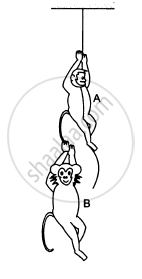Advertisements
Advertisements
प्रश्न
A stone is thrown vertically upward with a velocity of 9.8 m/s. When will it reach the ground?
उत्तर
Initial speed of ball is = 9.8 ms-1.
Acceleration due to gravity = -9.8 ms-2.
Final speed at maximum height = 0 ms-1.
We know v = u + at
0 = 9.8 - 9.8 t
T = 1 sec.
We know v2 - u2 =2as
At highest point final velocity is zero so
0 - 9.8 X 9.8 = 2 X (-9.8) S
S = 4.9 m.
for highest point initial velocity is zero
Acceleration due to gravity is = 9.8 ms-2.
Final velocity at ground is v
V2 - 0 = 2 X9.8 X 4.9
V = 9.8 ms-1.
Time taken to reach ground from highest point
V = u + at
9.8 = 0 + 9.8 t
T = 9.8/9.8 = 1 sec.
Total time = time of ascent + time of descent.
Total of flight = 1+ 1 = 2 seconds.
APPEARS IN
संबंधित प्रश्न
A constant retarding force of 50 N is applied to a body of mass 20 kg moving initially with a speed of 15 ms–1. How long does the body take to stop?
A helicopter of mass 1000 kg rises with a vertical acceleration of 15 m s–2. The crew and the passengers weigh 300 kg. Give the magnitude and direction of the
(a) force on the floor by the crew and passengers,
(b) action of the rotor of the helicopter on the surrounding air,
(c) force on the helicopter due to the surrounding air.
A person says that he measured the acceleration of a particle to be non-zero even though no force was acting on the particle.
The monkey B, shown in the following figure, is holding on to the tail of monkey A that is climbing up a rope. The masses of monkeys A and B are 5 kg and 2 kg, respectively. If A can tolerate a tension of 30 N in its tail, what force should it apply on the rope in order to carry monkey B with it? Take g = 10 m/s2.

A body of mass 5 kg is moving with velocity 2 m s-1. Calculate its linear momentum.
A force acts for 10 s on a stationary body of mass 100 kg, after which the force ceases to act. The body moves through a distance of 100 m in the next 5 s. Calculate: The velocity acquired by the body.
A force acts for 10 s on a stationary body of mass 100 kg, after which the force ceases to act. The body moves through a distance of 100 m in the next 5 s. Calculate : The magnitude of the force
A ball is thrown vertically upwards. It returns 6 s later. Calculate : The greatest height reached by the ball . (Take g = 10 m s-2)
A pebble is dropped freely in a well from its top. It takes 20 s for the pebble to reach the water surface in the well. Taking g = 10 m s-2 and speed of sound = 330 m s-1. Find : The time when echo is heard after the pebble is dropped.
Use Newton's second law to explain the following:
We always prefer to land on sand instead of hard floor while taking a high jump.
